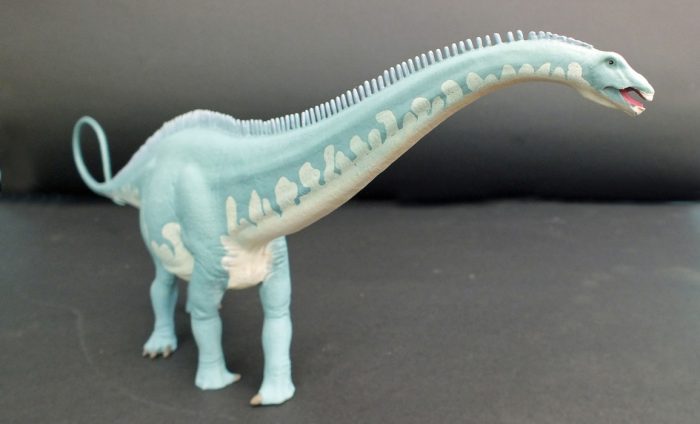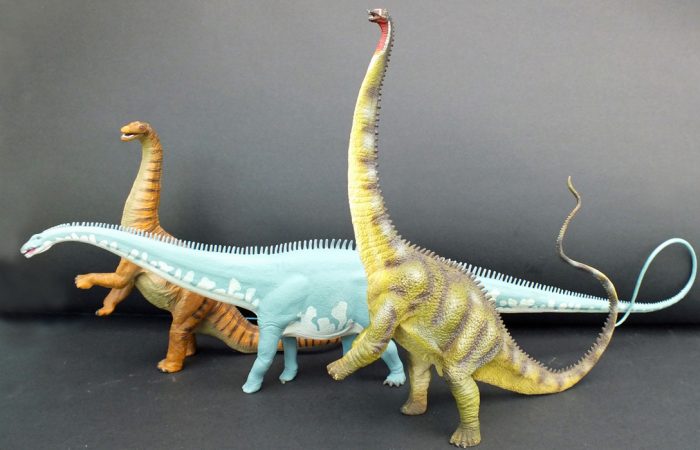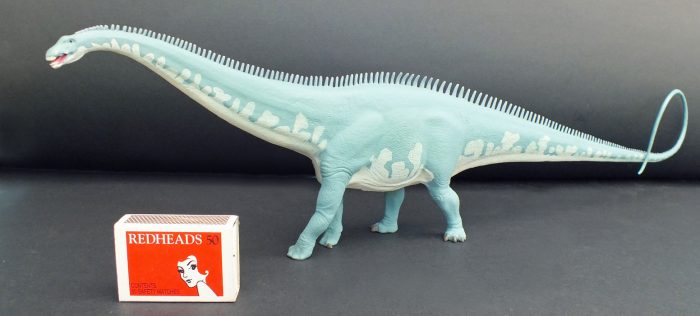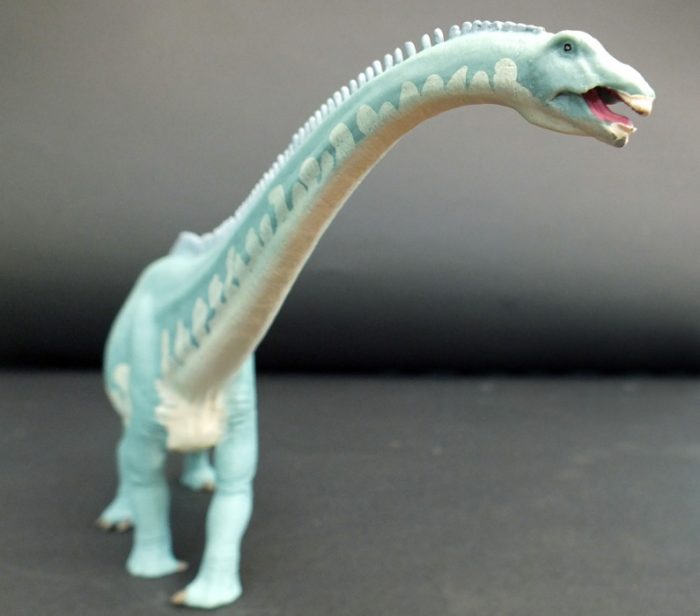Available from Amazon here.
For some reason, I can remember that one of the dinosaur books I had as a kid included a picture of a Diplodocus-style sauropod, with a quote from a paleontologist in the caption saying that “for most people, this is literally Mr Dinosaur himself”. It’s a comment that captures the unique fasciation of these animals, as the largest creatures ever to have walked the Earth. Everything about the sheer mass of these animals borders on the inconceivable, and yet modern reconstructions of sauropods emphasise that alongside their staggering size, these “earth-shaker lizards” possessed a sinuous, almost swan-like elegance and beauty. For this reason, sauropod figures have a special place in the hearts of many dinosaur model collectors. Today I review the newest potential addition to your herd, the 2017 Safari Diplodocus.

Diplodocus was first unearthed in 1877, and by now, countless millions of people must have gazed up at the many skeletal casts of Diplodocus featuring in museums around the world, as donated by the millionaire industrialist Andrew Carnegie in the early years of the twentieth century. Palaeontologist Gregory S Paul gives a size estimate of 25 metres and 12 tonnes for D. carnegii (in the dinosaur books I read as a kid, it seemed more or less compulsory to include a picture showing Diplodocus lined up alongside three busses parked end-to-end) and suggests that there may have been as many as 6 Diplodocus species, one of which, D. hallorum (the sauropod formerly known as Seismosaurus) may have reached 32 metres and 30 tonnes, making it a pretty decent candidate for the longest land animal ever (although not the most massive – sauropods from other branches of the family tree, such as brachiosaurs and titanosaurs, were much more heavily built). What’s really amazing is that four of the most famous of dinosaur giants, Diplodocus, the brontosaur Apatosaurus, Brachiosaurus and Camarasaurus, all lived together at the same time and place, in the Morrison Formation of late Jurassic North America, around 150 million years ago. What a truly astounding sight it must have seen these colossi together, wandering the same plains and drinking from the same watering holes…

But enough of this banter, what about the model? The first thing to note about this figure is it’s impressive size, which doesn’t really come across from the promotional photographs online. Although not as massive as the Carnegie collection sauropod figures of old, this is still a very hefty model that does justice to the imposing dimensions of the original beast. The length of the figure, (as posed with a tail that curves over upon itself), is about 47cm long. If you straighten out the tail, you get a total head-to-tail length of about 60cm, so accepting a 25 metre length estimate for the living animal, that gives us a scale that is pretty darn close to 1:40 (1:41.666 if you want to be precise). Furthermore, if you can manage to find a toy bus that is 20cm long, then you can use three of them to recreate that Diplodocus size-comparison illustration we all saw in the dinosaur books of our youth – isn’t it lucky that you have me to point these things out for you?

The pose of this Diplodocus is very handsome, and arguably superior to Safari Diplodocus figures that have preceded it, not least because the head and tail are in a more-or-less straight alignment, meaning that the model displays equally well from both sides. The thing that I like best about this figure’s pose it that it is so naturalistic – it really does look like a plausible animal, ambling through its late Jurassic habitat, relaxed and self-assured (mercifully, the protruding ‘shrink wrapped’ vertebra and ‘belly-almost-dragging-on-the-ground’ carriage of Papo’s sauropod monstrosity are not in evidence here). The way the whiplash tail curls over upon itself is a particularly appealing feature of the sculpt – it’s been speculated that living Diplodocus could twirl their tails around like this for communication and display within the herd. Iguana-like spines seem to show up on all manner of sauropod reconstructions these days, but in the case of the Diplodocus line of the sauropod family tree, there really are fossil skin impressions indicating this feature, so they make a welcome addition to the model. An aspect of the figure that will please many is that the hands (front feet) are depicted with only a single but large claw projecting laterally out from the side, which intuitively, looks a little odd, but is in fact in line with current paleontological views on sauropod anatomy. The musculature of the neck, where it joins onto the body, is portrayed as being rather deeper and more massive than on many older reconstructions that I’ve seen. I’m afraid I don’t know enough sauropod anatomy to comment on this from a technical standpoint, but purely in terms of aesthetics it looks plausible enough, and adds to this sculpts refreshingly contemporary and up-to-date feel.

I was excited to buy this figure, because the two-toned colour scheme with the dappled underbelly reminded me of the dinosaur art of Raul Martin, whose sauropod restorations must surely rank as among the most beautiful renditions of these animals. But unfortunately, it must be said that when the model is in hand, the surface details are a little disappointing. The skin is textured all over, but the depth of the texturing is slight, and not crisply cast. Consequently, the skin detailing seems flat and nondescript – in the picture below I’ve compared it with the skin texturing of the Collecta Diplodocus, which in my opinion is much more dynamic in its surface details. The colour scheme is based around a plausible-seeming (and not unattractive) shade of green-grey, and the underbelly mottling has an effectively organic look to it. But unfortunately, (on my example at least), the paint has not been well applied, appearing very thin and watered-down in places, and clumsily slapped-on in others, especially about the head. The eye is just a black dot, and the way the white for the teeth has been dashed all about the head gives my example something of an unfortunate bucked-tooth look. There is absolutely no tonal variation on the green-grey that covers most of the body, and this makes it rather overpowering visually – even the spines are in the same colour, which is a shame since a line of dark spines against the grey would really have made them a standout feature of the model. Even the most elementary of repainting efforts, (such as picking out the spines in black), would greatly improve the look of this guy. The blandness of the surface detailing and the lacklustre paint application do tend to make this figure seem more like a plastic lump of a toy than a scale replica for display, which is a real shame since the proportions and pose are so well thought-out.

Kids will no doubt really enjoy playing with this life-like Diplodocus, and would appreciate the flexibility of the whiplash tail as a way of adding some life and movement to the toy. As a collector’s model for the shelf, my conclusions are more equivocal. This is one of those figures that perhaps looks rather better from a distance than close up. From the promotional photographs online, I thought this was going to be a truly stunning model… the pose and form certainly give it the potential to be so, but unfortunately the execution of the surface detailing and paintwork have reduced the impact considerably. It’s still a very interesting and appealing model, just not the truly stunning figure that I feel it could have been. Sauropod fans will undoubtedly want to add this one to their herd, but more general-interest collectors will have to make up their own minds. I usually like to end my reviews with some atrocious pun, but given the various plusses and minuses of this figure, I’ll just remark that it is up to individual collectors to decide if they want to risk sticking their necks out for this one.

Available from Amazon here.
Support the Dinosaur Toy Blog by making dino-purchases through these links to Ebay and Amazon. Disclaimer: links to Ebay.com and Amazon.com on the The Dinosaur Toy Blog are often affiliate links, when you make purchases through these links we may make a commission

És sem találtam egy olyat,amin ne szúrtak volna el valamit,kár!
I bought it but now regret it, it just doesn’t look like a real living creature. The paintwork is sloppy and the colours are plain wrong.
Just received this specimen from Dejankins; I was late in ordering from Dean, due, I think, to the reservations expressed in John’s review (a good one, by the way). It was the last of that
generation on my “buy” list. Am I pleased? Yes. it’s a beautiful sculpt. The subtle nature of the texturing doesn’t seem to be problematic – at this scale, i think that it wouldn’t be as apparent as in the CollectA Diplodicus, for example. Also, the paint- work on my one is quite precise, so no problem. I really like the deep bases of neck and tail – they contribute to to the beautiful symetry of the animal. 4.5 stars for sure.
Thanks for the comments guys! To be clear, I wasn’t suggesting that this is a better model overall than the Carnegie Diplodocus, just that I thought that it has a better pose. From photos, the sculpted detail on the Carnegie version seems superior, but the U-shaped pose on the Carnegie (which means you can only display it on a shelf in one orientation) seems so awkward an unattractive to me that I never purchased it – and hence the lack of comparative photos!
No comparison pics to the Carnegie version?!?
It is truly disconcerting the choice of color for this Diplodocus, although it has very good details, they are not appreciated in full due to the color. An application of painting in several layers, as in the figure of Einiosaurus would have been more correct in my opinion.
I don’t mind the softer detail, since scales would probably not be hugely visible at that scale, but it is a shame about the sloppy paint job and weird color choice – it’s nice model and deserves better.
I suppose that now the toy dinosaur companies do not risk making figures of sauropods excessively large for the costs that would bring economically to the buyers said figures, and aside from this for the space that in a house supposes such type of figure, apart from This is risking a lot of money when it comes to marketing big figures that then unfortunately are very difficult to sell.
On the other hand it is for me a version superior to the one of the diplodocus of Collecta independently that also is a great figure. But it would be hypocritical if I did not say what I think as long as I respect the opinions of the other members of the forum and respect the companies.
Finishing I have and I am very happy to have bought it and above all I agree with the opinion of the author, although it should be noted that the diplodocus Carnegie is as good as this figure from my humble point of view and I would not point out that none of the Two is superior and more are matched in genius. Also thank the companies that such figures as the diplodocus of Safari this year are more resistant to abrasions by friction or falls.
Great review, BTW. And could you please add tags so that it’ll show up on the Wild Safari page, and in searches for Diplodocus toys?
I was hoping it would be larger, more in scale with the 2008 version. I was never a fan of the small scale sauropod figures, like Collecta’s Diplodocus or Argentinosaurus. Call me cynical, but a sauropod figure should be large.
It’s a nice-looking Diplodocus, but I still prefer the giant 2008 Carnegie Collection version.